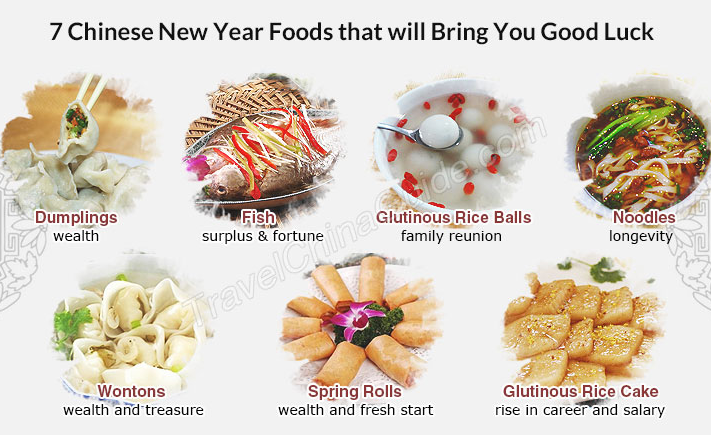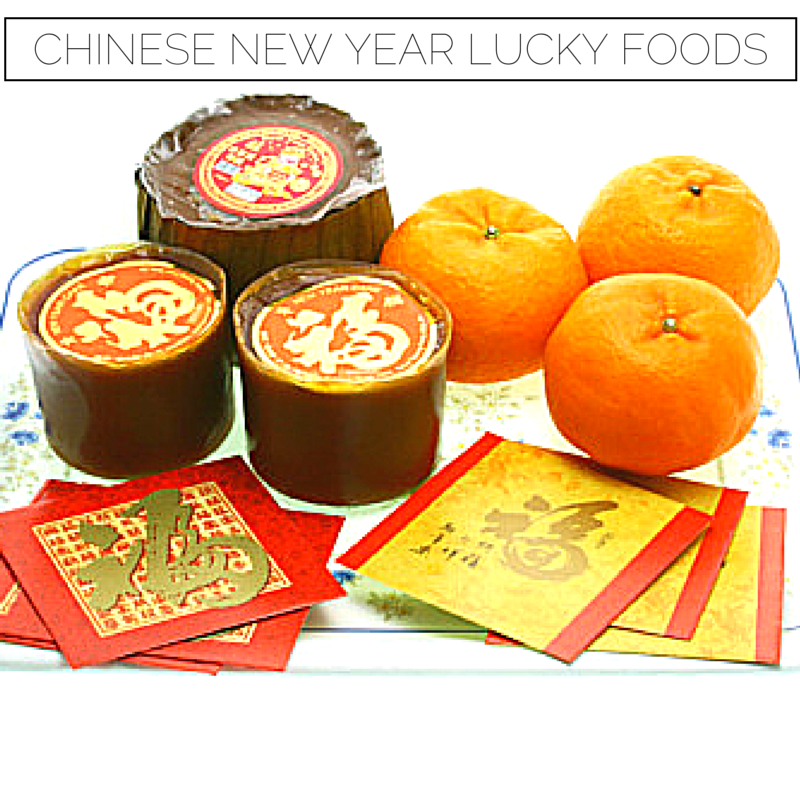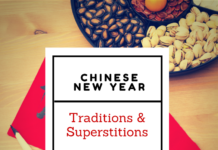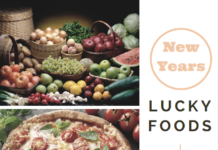Chinese New Years Lucky Foods
Food traditions are very important during the Chinese New Year. Having large meals means family togetherness. Many lucky foods are based on their pronunciation or appearance. Typical dishes include lucky fruits, dumplings & spring rolls. Fish dishes are also normally served as the main course because fish symbolizes hope for having a wealthy and prosperous new year ahead. Food plays a central role in Chinese New Year celebrations. Having abundant and symbolic foods represents family unity and hopes for a prosperous year ahead. Many dishes have auspicious meanings based on their names, appearance, or ingredients.
When visiting family and friends during the Chinese New Year, common greetings include “Xin Nian Kuai Le” (Happy New Year), “Gong Xi Fa Cai” (wishing you wealth and prosperity), and “Shen Ti Jian Kang” (wishing you good health).
Other Popular Chinese New Years Lucky foods include:
Chinese New Year candy box: (Tray of Togetherness), also known as a tray of togetherness or prosperity box, is usually a round platter with eight compartments filled with an interesting variety of snacks to share with family and friends. Each of the eight items in the tray of togetherness has a symbolic meaning meant to ensure a prosperous new year. For example, coconut is for togetherness, kumquats for prosperity, and red melon seeds for happiness.
Yu Sheng is a must-have for Chinese families every New Year. A raw fish salad that represents abundance and prosperity. The higher the toss while eating it, the higher one’s fortunes and vigor will grow in the coming year. It is a Teochew-style raw fish salad and symbolizes abundance, prosperity and vigor. It is believed that the height of the toss reflects the height of the diner’s growth in fortunes. Thus diners are expected to toss enthusiastically.

Long noodles: Long, Uncut cooked noodles (mian tiao) represent longevity and long life. Popular varieties include lo mein, cha soba, and udon.
Seafood: Fish is served whole with head and tail, symbolizing the end of one year and the beginning of another. Catfish, mud carp, and crucian carp are popular fish dishes. When set down on the table, the head of the fish should be placed towards the family elder or head of household, representing respect. Then the two people at the head and tail of the fish should drink together for luck. The person at the head of the fish should be the first one to serve himself or herself. Shrimp and prawns symbolize happiness and good fortune.

JiaoZi: For the Chinese New Year, Dumplings (jiao zi) are considered lucky because their shape resembles the silver ingots used as currency during the Ming Dynasty. Popular fillings include minced pork, diced chicken, shrimp or beef, and vegetables. Eating them signifies gaining wealth and prosperity. Tradition is for the family to make the dumplings together and then eat them at midnight. Some hide a coin in one of the dumplings, and whoever gets the coin will have extra luck in the coming year. Eat up, as it is thought that the more dumplings you eat, the more money you will make in the new year.
Nian Gao (New Year Cake): The tradition of eating rice cakes dates back over 3,000 years. This steamed fruit cake is made from glutinous rice flour, brown sugar, and oil. It is usually offered to the kitchen god so that he will take back a favorable report before returning to heaven at the start of the new year. You can also bake them vs. steaming. The sticky cake represents binding families together and is believed to bring prosperity. Its sweetness also signifies hopes for a sweet, prosperous year. Popular varieties include brown sugar, red bean, and fruit flavors.
Related: Chinese New Years Traditions & Superstitions
Bakkwa: The salty-sweet jerky is usually made from pork and turns a lucky red color when dried. A popular dish eaten during the New Year celebration because of its lucky red color, bakkwa is a salty and sweet dried meat similar to jerky and is usually made of pork. Treated as a delicacy, it is a popular gift to give and receive during New Year festivities.
Black moss seaweed: Signifies wealth and good fortune. Used in soups, vegetarian dishes, and garnishes. We have a list of new years lucky soups with a few recipes you can try.
Eight Treasures Rice: Dating as far back as 1123 BC, this rice pudding is sticky, sweet, and often eaten on New Year’s. A sweet rice pudding that features 8 dried fruits and nuts, hence the name. The 8 items often used are red dates, lotus seeds, walnuts, dates, pine nuts, raisins, dried apricots, and pistachios combined with glutinous rice, sweetened bean paste, lard or oil and sugar. You can use different items if you wish, but stick with 8, as that is a lucky number in China. We have a list of Chinese New Years lucky desserts listed in a separate post if you would like to learn more.

Tang Yuan: (Sweet rice balls) The 15th day of the Chinese New Year known as Yuanxiao Festival (a/k/a the Lantern Festival.) Since the rice balls are round, it is supposed to signify the circle of unity and harmony within the family. Depending on the region, some rice balls are filled with things like meat, vegetables, sugar, sesame or sweet bean, or chocolate paste, whereas others have no filling and are used in soups, syrup, or tea. Although it originated during the Chinese New Year & Winter Solstice festivals, Tang Yuan has evolved and is often eaten at weddings and other family celebrations.

Citrus Fruit: Pomelos and oranges signify abundant blessings and prosperity. The golden color is considered lucky. Eating them on the 15th day is thought to bring romantic fortune. Pomelo is a large citrus fruit thought to bring continuous prosperity in the new year. Many also eat tangerines and oranges because of their golden color also thought to represent prosperity in the new year. In Malaysia and Singapore, the 15th day of Chinese New Year is celebrated by individuals seeking a love partner. Single women would write their contact numbers on mandarin oranges and throw them in a river or a lake, while a single man would collect them and eat them oranges. The taste is an indication of their possible love: sweet represents a good fate, while sour represents a bad fate!!!
Duck: Seen as a symbol of fidelity and marital bliss. Served whole to represent beginnings and endings. Like fish, it is served whole, representing the end of a year and the beginning of another, but also because some believe that slicing or cutting can represent negative things, like the severing of family ties.
Related: Feng Shui Good Luck Tips for the New Year; New Year’s Lucky Foods
Regional Dishes and Variations
While many lucky foods are popular nationwide, some dishes have special regional meanings and importance:
- Southern China: Fat choy and sea moss symbolizing prosperity are heavily used in dishes. Buddha Jump Over the Wall is a complex stew served.
- Northern China: Dumplings dominate the feast. Boiled dumplings represent silver or gold nuggets, pan-fried ones mean prosperity.
- Eastern and Western China: Jiaozi dumplings stuffed with leek and egg symbolize the growth of wealth. Fish is also eaten on the eve rather than New Year’s Day.
- Desserts and sweets like nian gao rice cake and tang yuan rice balls are more common in southern and eastern regions.
Overseas Variations:
- Some overseas Chinese add new culinary traditions to the feast using locally available ingredients. Bak kwah jerky, for example, is popular in Southeast Asia.
- Items like pineapple tarts and love letters (a flaky pastry) are served in parts of Malaysia and Singapore for blessings, added to traditional Chinese dishes.
- The Chinese diaspora have added creative spins on jiaozi fillings using ingredients like cheese, chili, and avocado not used back in China.
Home Cooking vs Eating Out:
- Families traditionally gather at home to make dumplings together by hand before the New Year’s Eve feast. The preparation is key to familial bonding.
- In recent years, more younger Chinese working abroad or in cities eat out or order delivery for the New Year’s Eve reunion dinner. But home cooked meals still hold cultural significance.
Additional Customs:
- Some Buddhist and Daoist adherents prepare vegetarian lucky foods instead of meat-based dishes. Ingredients like tofu and mock meats symbolizing blessings are used.
- For breakfast on New Year’s Day, many families eat a vegetarian dish called Buddha’s Delight, representing hopes for a prosperous first day of the new year.
Some traditions/superstitions also include cleaning your house prior to the New Year, but no cleaning the day of the Chinese New Year, or wiping away good luck. Don’t use knives or sharp objects on new years. Using knives or sharp objects on New Year’s Day is considered unlucky since it symbolically “cuts” fortune and luck. Setting off firecrackers scares away evil spirits and misfortune. Give red envelopes with money to children to keep the children healthy and living long. Decorating with red lanterns, banners, clothing brings luck, success, and joy. Red is considered an auspicious color. With dishes carrying so many symbolic blessings, the extensive New Year’s feast is central to hopes for an abundant year filled with prosperity, happiness, and good health for the family.
We invite you to visit our Chinese New Years Lucky Foods Pinterest Board.









